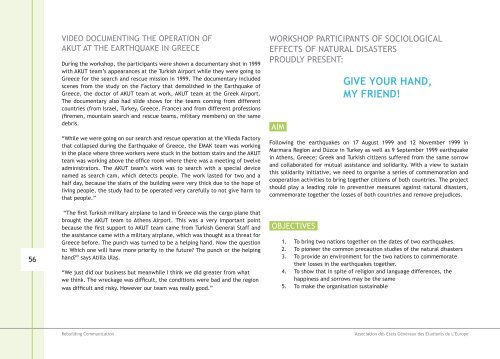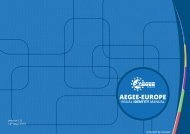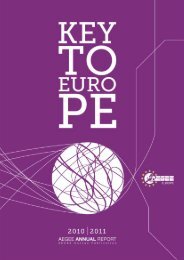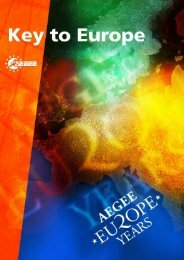turkish-greek civic dialogue - AEGEE Europe
turkish-greek civic dialogue - AEGEE Europe
turkish-greek civic dialogue - AEGEE Europe
You also want an ePaper? Increase the reach of your titles
YUMPU automatically turns print PDFs into web optimized ePapers that Google loves.
56<br />
VIDEO DOCUMENTING THE OPERATION OF<br />
AKUT AT THE EARTHQUAKE IN GREECE<br />
During the workshop, the participants were shown a documentary shot in 1999<br />
with AKUT team’s appearances at the Turkish Airport while they were going to<br />
Greece for the search and rescue mission in 1999. The documentary included<br />
scenes from the study on the Factory that demolished in the Earthquake of<br />
Greece, the doctor of AKUT team at work, AKUT team at the Greek Airport.<br />
The documentary also had slide shows for the teams coming from different<br />
countries (from Israel, Turkey, Greece, France) and from different professions<br />
(firemen, mountain search and rescue teams, military members) on the same<br />
debris.<br />
“While we were going on our search and rescue operation at the Vileda Factory<br />
that collapsed during the Earthquake of Greece, the EMAK team was working<br />
in the place where three workers were stuck in the bottom stairs and the AKUT<br />
team was working above the office room where there was a meeting of twelve<br />
administrators. The AKUT team’s work was to search with a special device<br />
named as search cam, which detects people. The work lasted for two and a<br />
half day, because the stairs of the building were very thick due to the hope of<br />
living people, the study had to be operated very carefully to not give harm to<br />
that people.”<br />
“The first Turkish military airplane to land in Greece was the cargo plane that<br />
brought the AKUT team to Athens Airport. This was a very important point<br />
because the first support to AKUT team came from Turkish General Staff and<br />
the assistance came with a military airplane, which was thought as a threat for<br />
Greece before. The punch was turned to be a helping hand. Now the question<br />
is: Which one will have more priority in the future? The punch or the helping<br />
hand?” says Atilla Ulaş.<br />
“We just did our business but meanwhile I think we did greater from what<br />
we think. The wreckage was difficult, the conditions were bad and the region<br />
was difficult and risky. However our team was really good.”<br />
WORKSHOP PARTICIPANTS OF SOCIOLOGICAL<br />
EFFECTS OF NATURAL DISASTERS<br />
PROUDLY PRESENT:<br />
GIVE YOUR HAND,<br />
MY FRIEND!<br />
Rebuilding Communication Association des Etats Généraux des Etudiants de L’<strong>Europe</strong><br />
AIM<br />
Following the earthquakes on 17 August 1999 and 12 November 1999 in<br />
Marmara Region and Düzce in Turkey as well as 9 September 1999 earthquake<br />
in Athens, Greece; Greek and Turkish citizens suffered from the same sorrow<br />
and collaborated for mutual assistance and solidarity. With a view to sustain<br />
this solidarity initiative, we need to organise a series of commemoration and<br />
cooperation activities to bring together citizens of both countries. The project<br />
should play a leading role in preventive measures against natural disasters,<br />
commemorate together the losses of both countries and remove prejudices.<br />
OBJECTIVES<br />
1. To bring two nations together on the dates of two earthquakes.<br />
2. To pioneer the common precaution studies of the natural disasters<br />
3. To provide an environment for the two nations to commemorate<br />
their losses in the earthquakes together.<br />
4. To show that in spite of religion and language differences, the<br />
happiness and sorrows may be the same<br />
5. To make the organisation sustainable







